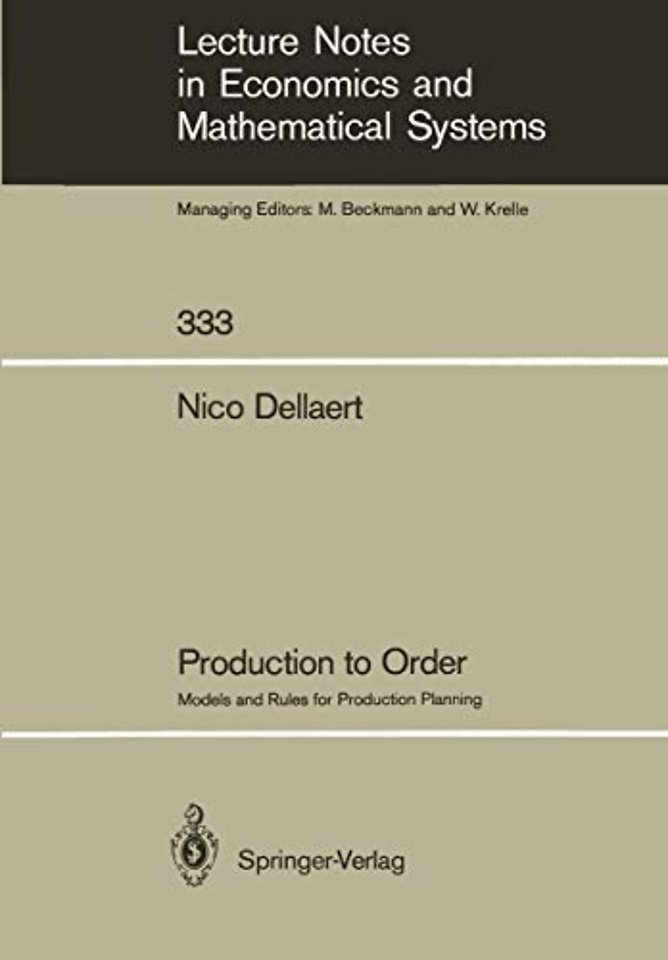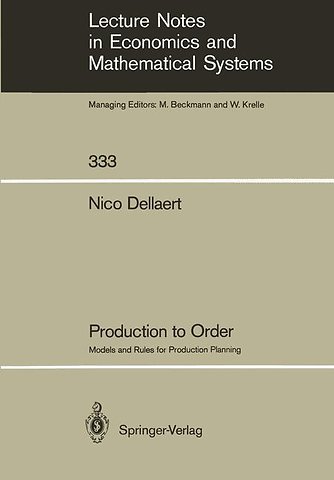1. Introduction.- 1.1. Production to order.- 1.2. Description of the problem.- 1.3. The control rules.- 1.3.1. The control rules for the lead times.- 1.3.2. The control rules for the production planning.- 1.4. The performance of the control rules.- 1.5. Influences on the control rules.- 1.5.1. Influence of the market.- 1.5.2. Influence of the production facilities.- 1.6. The methods.- 1.7. Overview of the text.- 2. Preliminaries.- 2.1. The situation and the model.- 2.2. Costs as instruments for decision making.- 2.3. Control rules for production planning.- 2.4. Control rules for lead times and order acceptance.- 3. A Fixed Production Cycle.- 3.1. Introduction.- 3.2. Analysis of fixed production cycles.- 3.2.1. Extended gating cyclic service model.- 3.2.2. Normal gating cyclic service with strict capacity.- 3.2.3. Normal gating service with flexible capacity.- 4. Non Cyclic Methods for One Product Type.- 4.1. Introduction.- 4.2. Fixed lead times.- 4.2.1. Introduction.- 4.2.2. Description of the model.- 4.2.3. The optimal production policy.- 4.2.4. Heuristic procedures.- 4.2.4.1. Notation.- 4.2.4.2. The Silver-Meal approach.- 4.2.4.3. The Wagner-Whitin approach.- 4.2.4.4. The (x,T)-rule.- 4.2.5. Numerical results.- 4.2.5.1. Conclusions.- 4.2.6. Orders with different priorities.- 4.2.6.1. Introduction.- 4.2.6.2. Model.- 4.3. A fluctuating demand rate.- 4.3.1. Introduction.- 4.3.2. Model.- 4.3.3. Example of lateness-dependent demand.- 4.3.4. Numerical results.- 4.4. A decision rule for lead times.- 4.4.1. Introduction.- 4.4.2. The model.- 4.4.3. A cyclic approach.- 4.4.4. The dynamic programming rule.- 4.4.5. Simplified dynamic programming rule.- 4.4.6. Numerical results.- 5. Several Types of Products on One Machine.- 5.1. Introduction.- 5.1.1. Description of the model.- 5.1.2. Notation.- 5.2. No possibilities for working overtime.- 5.2.1 Introduction.- 5.2.2. Extended (x,T)-rule.- 5.2.2.1. Introduction to the extended (x,T)-rule.- 5.2.2.2. Formulation of the extended (x,T)-rule.- 5.2.3. The two-step rule.- 5.2.3.1. Introduction to the two-step rule.- 5.2.3.2. Formulation of the first part.- 5.2.3.3. Formulation of the second part.- 5.2.4. A semi-fixed cycle rule.- 5.2.4.1. Introduction.- 5.2.4.2. Determining a semi-fixed cycle.- 5.2.5. Numerical results.- 5.3. Situation in which extra capacity is available.- 5.3.1. Introduction.- 5.3.2. Extended overtime (x,T)-rule.- 5.3.2.1. Introduction to the extended overtime (x,T)-rule.- 5.3.2.2. Formulation of the extended overtime (x,T)-rule.- 5.3.3. The two-step overtime rule.- 5.3.4. The semi-fixed cycle rule.- 5.3.5. Numerical results.- 6. Analysis of Multi-Type Models.- 6.1. Introduction.- 6.2. The multi (x,T)-rule.- 6.2.1. Analysis of the multi (x,T)-rule.- 6.2.2. Numerical results.- 6.2.3. Other possibilities and conclusions.- 6.3. Continuous review model.- 6.3.1. Introduction.- 6.3.2. Production model.- 6.3.3. Decomposition model.- 6.3.4. Results for the normal extended service.- 6.3.5. Numerical results and comparison with fixed cycle.- 7. The (x,T)-Rule in Complex Situations.- 7.1. Description of the problem.- 7.2. The elements of the extended (x,T)-rule.- 7.2.1. The penalty points.- 7.2.2. The allocation of capacity.- 7.2.3. Planning on different machines.- 7.3. Determination of lead times.- 7.3.1. Acceptance of the lead times.- 7.4. Numerical results.- 8. Summary and Conclusions.- 8.1. Summary and conclusions.- References.







